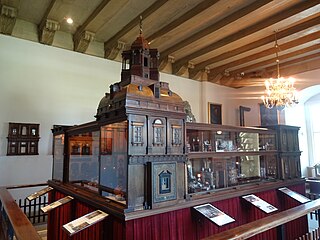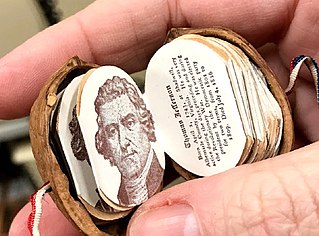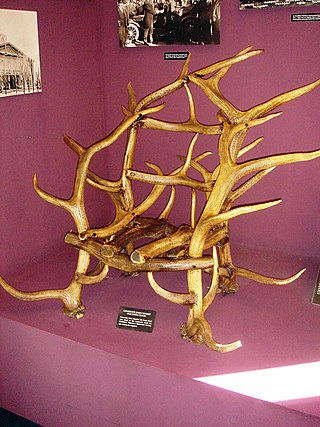
Belcourt is a former summer cottage designed by architect Richard Morris Hunt for Oliver Hazard Perry Belmont and located on Bellevue Avenue in Newport, Rhode Island. Construction was begun in 1891 and completed in 1894, and it was intended to be used for only six to eight weeks of the year. Belcourt was designed in a multitude of European styles and periods; it features a heavy emphasis on French Renaissance and Gothic decor, with further borrowings from German, English, and Italian design. In the Gilded Age, the castle was noted for its extensive stables and carriage areas, which were incorporated into the main structure.

The Wallace Collection is a museum in London occupying Hertford House in Manchester Square, the former townhouse of the Seymour family, Marquesses of Hertford. It is named after Sir Richard Wallace, who built the extensive collection, along with the Marquesses of Hertford, in the 18th and 19th centuries. The collection features fine and decorative arts from the 15th to the 19th centuries with important holdings of French 18th-century paintings, furniture, arms and armour, porcelain and Old Master paintings arranged into 25 galleries. It is open to the public and entry is free.

A dollhouse or doll's house is a toy house made in miniature. Since the early 20th century dollhouses have primarily been the domain of children, but their collection and crafting is also a hobby for many adults. English-speakers in North America commonly use the term dollhouse, but in the United Kingdom and other English-speaking countries the term is doll's house. They are often built to put dolls in.

Queen Mary's Dolls' House is a dollhouse built in the early 1920s, completed in 1924, for Queen Mary, the wife of King George V. It was designed by architect Sir Edwin Lutyens, with contributions from many notable artists and craftsmen of the period, including a library of miniature books containing original stories written by authors including Sir Arthur Conan Doyle and A. A. Milne.

The Burrell Collection is a museum in Glasgow, Scotland, managed by Glasgow Museums. It houses the art collection of Sir William Burrell and Constance, Lady Burrell. The museum opened in 1983 and reopened on 29 March 2022 following a major refurbishment. It was announced as the winner of the Art Fund Museum of the Year in July 2023. It is the only non-national museum to be the outright winner twice.

Titania's Palace is a miniature castle (dollhouse) that was hand-built in Ireland by James Hicks & Sons, Irish Cabinet Makers, who were commissioned by Sir Nevile Wilkinson from 1907 to 1922. Wilkinson's daughter Guendolen claimed to have seen a fairy running under the roots of a tree, in a wood beside their home at Mount Merrion House. It is said that Guendolen felt sorry for the fairies, who have to live in caves.

A miniature book is a very small book. Standards for what may be termed a miniature rather than just a small book have changed through time. Today, most collectors consider a book to be miniature only if it is 3 inches or smaller in height, width, and thickness, particularly in the United States. Many collectors consider nineteenth-century and earlier books of 4 inches to fit in the category of miniatures. Book from 3–4 inches in all dimensions are termed macrominiature books. Books less than 1 inch in all dimensions are called microminiature books. Books less than 1/4 inch in all dimensions are known as ultra-microminiature books.

Nationalmuseum is the national gallery of Sweden, located on the peninsula Blasieholmen, in central Stockholm.

Shelburne Museum is a museum of art, design, and Americana located in Shelburne, Vermont, United States. Over 150,000 works are exhibited in 39 exhibition buildings, 25 of which are historic and were relocated to the museum grounds. It is located on 45 acres (18 ha) near Lake Champlain.

A room box is a display box used for three-dimensional miniature scale environments, or scale models. Although the name would suggest room boxes generally only represent typical rooms such as those found in houses or other buildings, room boxes are used for all sorts of environments – exterior views as well as interior ones, realistic ones as well as fantastical ones. While some miniaturists concentrate their efforts specifically on room boxes, many use them to take a break from larger projects, such as dollhouses or miniature villages, to create a smaller environment on a different theme. A room box can be tailored to one’s interests or mirror an important step in life - for example, a bakery or restaurant scene might be created by or for a baker or cook, and a wedding dress storefront might be created for a bride to be or as a reminiscence of one's wedding. Making a room box is often a first step to learning new techniques in miniature making; such projects are popular at miniaturists' events where attendees have only 1–2 days to make and finish a project. Once techniques are perfected in these smaller settings, craftspersons and hobbyists often reapply them to larger projects.

The Rahr–West Art Museum is an art museum in Manitowoc, Wisconsin. It is located in the Joseph Vilas Jr. House, which is listed on the National Register of Historic Places. The house is a significant example of Queen Anne style architecture in the United States.

Horn furniture is a name given to furniture which is manufactured completely by shed antlers or pieces of furniture such as e.g. cabinets which are appliqued with antler elements such as carved horn roses or with antler pieces from tusks, fallow deer, stag and deer. Trophies of chase have already been used during the late Middle Age for furnishing and in modern times furniture makers use the horns and antlers of animals such as cattle, antelope, moose and elk.

Sara Rothé (1699–1751) was an 18th-century art collector from the Northern Netherlands, known today as the former owner of two dollhouses now on display in the Frans Hals Museum and the Gemeentemuseum Den Haag.

Narcissa Niblack Thorne was an American artist known for her extremely detailed miniature rooms. Her works depict historical interiors from Europe, Asia and North America from the late 13th to the early 20th century. The Thorne rooms are honored with dedicated exhibits in the Phoenix Art Museum, the Knoxville Museum of Art, and the Art Institute of Chicago, where a special wing was built to house them.

The Antique Furnishings & Wooden Sculpture Museum of Milan is located on the first floor of the Sforza Castle ducal courtyard and it is part of the Sforza Castle's Civic Museum complex.
Dorothy Rogers (1882–1952) was a famed creator of miniature needlework carpets exhibited during her lifetime and avidly collected after her death. Rogers began her lifetime obsession in her twenties while building a dollhouse for her young daughter. Her husband, an English army Colonel stationed in India, soon joined her in her craft, and the two spent decades engaged in intensive collaborative research and innovation. Rogers modeled many carpets on existing examples in prominent British collections while providing subtle alterations to existing styles. A number of Rogers' carpets contain personalized and possibly coded inscriptions.

Grand Jamia Mosque Lahore is a mosque located in Bahria Town, Lahore, Pakistan. With a capacity of 70,000 worshippers, it is the third largest mosque in Pakistan and the fourteenth largest mosque in the world.

Bjäresjö Church is a medieval church in Bjäresjö, in the province of Skåne, Sweden. The church contains several medieval mural paintings as well as a richly decorated Romanesque baptismal font.

The Thorne miniature rooms are a set of approximately 100 miniature models of rooms created between 1932 and 1940 under the direction of Narcissa Niblack Thorne. Ninety-nine of the rooms are believed still to be in existence; the majority (68) are on display at the Art Institute of Chicago, while 20 are at the Phoenix Art Museum, nine at the Knoxville Museum of Art, and one each at The Children's Museum of Indianapolis and the Kaye Miniature Museum in Los Angeles. The Art Institute's rooms document European and American interiors from the late 13th century to the 1930s and the 17th century to the 1930s, respectively. Constructed on a 1:12 scale, the rooms are largely made of the same materials as full-sized rooms, and some even include original works of art.
Sherry Brody was an American artist and pioneering member of the feminist art movement. Brody is known for her work on the Womanhouse project. Her sculpture, The Dollhouse, is in the Smithsonian Museum of American Art collection.




















